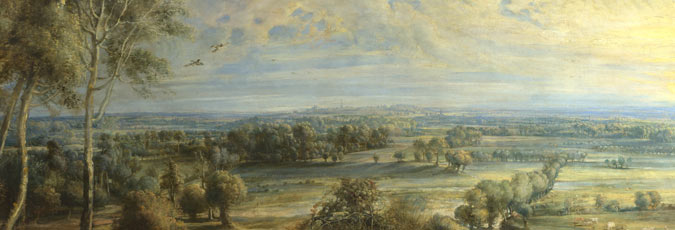Environmental risks
The main ‘environmental risks’ to which paintings are subject are unsuitable levels of moisture in the air surrounding them while on display, or in storage spaces, and also unsuitable temperatures, unsuitable levels of light and exposure to atmospheric pollutants. Attacks by insects, fungi and microorganisms are fairly easy to control in well-managed buildings, but can be damaging and require monitoring. Of these environmental factors, the two most significant are: rapidly changing levels of atmospheric moisture (measured as the climatic factor termed relative humidity, or RH) and excessive light levels. For paintings these environmental factors require close control to ensure preservation. Temperature changes are a lesser problem, and paintings are generally quite safe in the temperature ranges usually considered suitable for human comfort indoors. There are effective means, largely using air-filtration, of reducing atmospheric pollutants within buildings, including museums.
Easel paintings
Traditional Old Master paintings, normally described as ‘easel paintings’, involve pigments bound in egg, oil, glue, or mixtures of these media, on supports of wood panel or canvas. Among cultural objects generally, such easel paintings are exceptionally complex in their material constitution. Unusually stringent demands of environmental control are required to ensure their preservation, predominantly because so many different materials, and separate classes of materials, are brought together in the making of these objects. This diverse material nature has been the focus of a number of National Gallery publications, particularly the series 'Art in the Making' and many articles in the National Gallery Technical Bulletin. Each of the various component elements in a painting can respond differently towards environmental factors such as changing relative humidity (RH) or high light levels.
There are two additional complexities. First, easel paintings are multi-layered objects and they very often display mechanical weaknesses at the interfaces of different parts of the structure, for example between a ground layer and the support (whether on wood panel or canvas), between paint and ground, or between the various superimposed paint layers that make up a painting. Even small movements in the overall structure, particularly movements in the support, can seriously weaken these interfaces, sometimes to the point of failure. Second, paintings of any significant age have already undergone various complex and unpredictable processes of change and degradation – for example, there may be extensive cracking of the paint layers – which can lead to structural weaknesses not present in the picture when it was newly created. There are many effects of age in pictures which can cause them to become more fragile over time than their undegraded, newly finished states would imply.
Because easel paintings are both structurally and materially complex, and because each is unique in its state of preservation, it is not possible to carry out scientific tests on models or on simulated paintings to assess the response of real, aged paintings to environmental factors and environmental changes such as shifting ambient relative humidity. Research to this end has not so far reached a stage of development to prove useful to those with custody of genuine, fragile works of art. Real paintings are very much more fragile than experimental test models which significantly over-simplify the nature of the problem, particularly with regard to their complex mechanical behaviour.
Next: Questions and Answers

